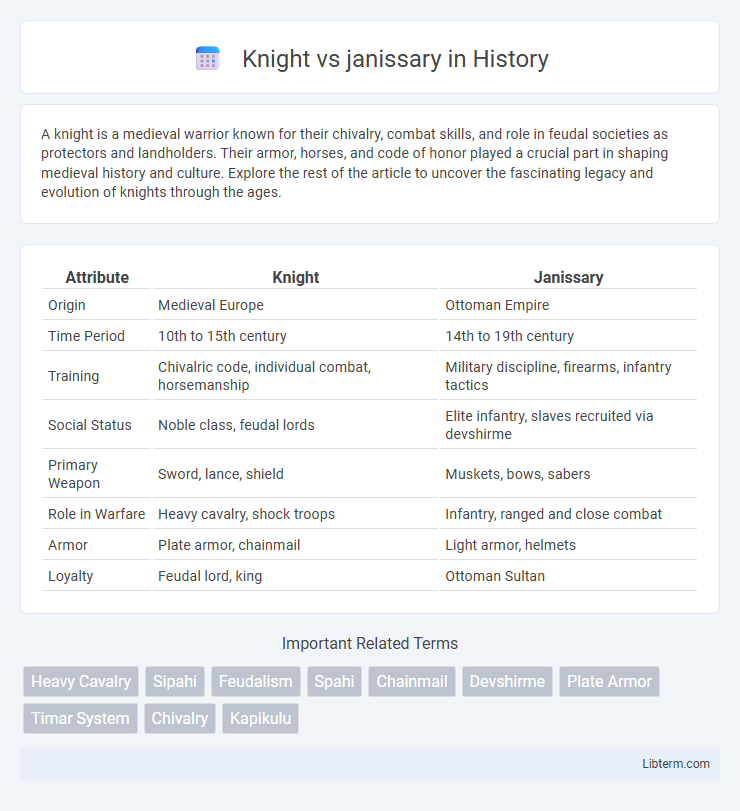A knight is a medieval warrior known for their chivalry, combat skills, and role in feudal societies as protectors and landholders. Their armor, horses, and code of honor played a crucial part in shaping medieval history and culture. Explore the rest of the article to uncover the fascinating legacy and evolution of knights through the ages.
Table of Comparison
| Attribute | Knight | Janissary |
|---|---|---|
| Origin | Medieval Europe | Ottoman Empire |
| Time Period | 10th to 15th century | 14th to 19th century |
| Training | Chivalric code, individual combat, horsemanship | Military discipline, firearms, infantry tactics |
| Social Status | Noble class, feudal lords | Elite infantry, slaves recruited via devshirme |
| Primary Weapon | Sword, lance, shield | Muskets, bows, sabers |
| Role in Warfare | Heavy cavalry, shock troops | Infantry, ranged and close combat |
| Armor | Plate armor, chainmail | Light armor, helmets |
| Loyalty | Feudal lord, king | Ottoman Sultan |
Origins of the Knight and Janissary
Knights originated in medieval Europe during the 9th to 15th centuries as heavily armored cavalry serving feudal lords and following a chivalric code rooted in Christian values. The Janissaries were an elite infantry corps established in the 14th century by the Ottoman Empire, composed primarily of conscripted Christian youths converted to Islam and trained as professional soldiers. Both groups symbolize distinct military evolutions: knights embodying feudal warrior aristocracy and janissaries representing a centralized, disciplined standing army.
Historical Context and Emergence
The Knight and Janissary represent distinct military classes originating from medieval Europe and the Ottoman Empire, respectively. Knights emerged during the feudal era as heavily armored cavalry, bound by chivalric codes and serving European monarchs between the 9th and 15th centuries. Janissaries formed in the 14th century through the devshirme system, recruiting Christian youths to become elite infantry units loyal to the Ottoman Sultan, playing a crucial role in Ottoman military expansion.
Recruitment and Social Status
Knights were typically recruited from noble families, inheriting their status through lineage and often trained from youth in martial and chivalric skills, embodying the medieval European aristocracy's ideals. Janissaries, on the other hand, were forcibly recruited through the devshirme system, where Christian boys from the Ottoman Empire were converted to Islam and rigorously trained as elite infantry soldiers, rising from humble origins regardless of their birth status. While knights reinforced existing social hierarchies, janissaries created a meritocratic military class with significant social mobility within the Ottoman imperial structure.
Training and Education
Knights underwent rigorous training from childhood, beginning as pages and squires, focusing on horseback riding, weapon mastery, and chivalric principles, often within noble households. Janissaries were recruited through the devshirme system, receiving intense military and religious education in Ottoman schools, emphasizing discipline, firearms proficiency, and Islamic teachings. Both institutions relied on structured, lifelong training to create elite warriors integral to their respective military systems.
Armor and Weaponry Comparison
Knights wore heavy plate armor made of steel, providing extensive protection but limiting mobility, while Janissaries used lighter chainmail and leather armor, favoring agility in battle. Knights typically wielded swords, lances, and maces designed for close combat and heavy impact, whereas Janissaries were equipped with composite bows, muskets, and curved swords like the yatagan, enabling effective ranged attacks and swift strikes. The contrasting armor and weaponry reflect differing military tactics: knights emphasized heavy cavalry charges, and Janissaries specialized in flexible infantry tactics with superior ranged capabilities.
Battlefield Tactics and Roles
Knights relied heavily on heavy cavalry charges to break enemy lines with armored lances and swords, employing shock tactics that capitalized on momentum and discipline in open-field battles. Janissaries functioned as elite infantry units equipped with firearms and muskets, using coordinated volleys and disciplined formations to deliver sustained firepower and counter cavalry advances. While knights dominated through melee combat and close-quarters fighting, Janissaries utilized ranged tactics, strategic positioning, and combined arms support to control battlefield dynamics.
Code of Conduct and Discipline
Knights adhered to a strict code of chivalry emphasizing honor, loyalty, and bravery, with rigid discipline enforced through noble hierarchy and religious vows. Janissaries operated under the Ottoman military order, bound by intense discipline, obedience, and loyalty to the Sultan, enforced through daily rigorous training and strict hierarchical command. Both forces maintained their effectiveness through unwavering adherence to their distinct codes of conduct and discipline systems.
Influence on Warfare Evolution
Knights revolutionized medieval warfare with heavy cavalry tactics, emphasizing armor, mounted combat, and feudal loyalty, which shaped the battlefield strategies of Europe from the 9th to 15th centuries. Janissaries introduced disciplined, firearm-equipped infantry units to Ottoman warfare, pioneering the integration of gunpowder weapons with traditional military formations during the 14th to 19th centuries. This transition from heavily armored knights to firearm-armed infantry marked a critical evolution in military technology, organization, and combat effectiveness across Eurasian battlefields.
Legendary Battles and Notable Figures
The legendary battles between Knights and Janissaries exemplify the clash between medieval chivalry and Ottoman military prowess, with the Siege of Constantinople (1453) standing as a pivotal conflict where Janissaries showcased superior gunpowder tactics against heavily armored Knights. Notable figures include Sultan Mehmed II, whose leadership orchestrated the Janissary dominance, and Richard the Lionheart, symbolizing the valor and discipline of Knights during the Crusades. The enduring legacy of these warriors highlights the evolution of warfare from armored cavalry to elite infantry trained in early firearm use.
Legacy and Impact on Modern Military
The Knight and Janissary embodied distinct military legacies that shaped modern warfare's evolution; knights pioneered chivalric codes and heavy cavalry tactics influencing Western martial traditions, while Janissaries introduced disciplined infantry formations and state-controlled military recruitment central to Ottoman power. Their methods contributed to the professionalization of armies, with the Janissary system inspiring modern standing army principles and the knightly emphasis on armor and mounted combat informing contemporary cavalry concepts. The enduring impact of both highlights a convergence of medieval martial innovations into modern military organization, strategy, and cultural identity.
Knight Infographic

 libterm.com
libterm.com